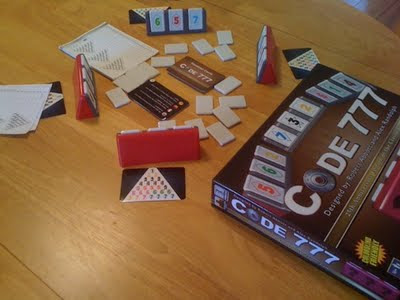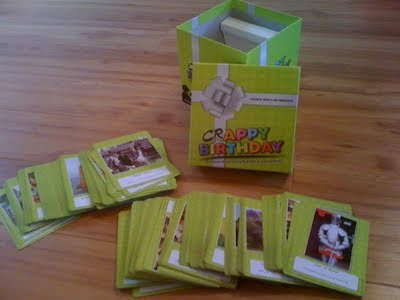A game that I paid little to no attention to until it was mailed to me after the tornado is Code 777
In Code 777, each player has 3 tiles that are placed on a board in front of them. All of the other players can see what that player has, but they cannot - the goal of the game is to figure out which numbers you have. Each turn, the active player gets a question which he must read aloud and answer to all of the other players. Questions like, "How many numbers do you not see at all?" This information will then help other players determine what their tiles are. Whenever a player thinks that they know what their numbers are, they are able to guess - but if they are wrong, then they lose their tiles and get new ones. This helps their opponents and forces them to start over. Play continues like this until one player guesses their numbers correctly.
The first thing that I like about Code 777 is that each tile has both a number and a color (you only have to guess the number, not the color). This really helps the questions to be much more diverse - "Do you see more green or blue tiles?" Therefore, there are a lot of different ways that you can narrow down which tiles you may or may not have. And, whoever is best and narrowing this down is normally able to win. (And as a note, the Stronghold Games version of Code 777 is color-blind friendly. Each piece has both a color and a matching symbol on it.)
The next major pro to this game is that it is incredibly fun. As an honesty check, I really only played this game to see what it was like since I had a copy available to me, and after playing it, I was intending to pass it along to someone else (that can also be read "it sure didn't look fun"). However, after the first play, I got hooked! This game is one of the most fun games that I have played in quite some time. It is incredibly difficult to objectively describe this, and I have no idea what even causes this game to be fun (by all typical gauges, I'm convinced that it should be boring), but everyone that I have played it with has had a blast!
The third pro that I will mention is that I really liked the balance of the "number pyramid." Each number has one more tile available than the previous number (there is one "1", two "2"s, etc). In addition, each color is used four times - there are four brown "4"s, there are three black "3"s and one black "5", etc. This careful balance in the game (and realizing that it is there) really allows the questions to be much more useful whether they are about numbers or colors.
The final pro that I will mention is that I think that Code 777 is kid (that can read - so maybe more "tween" (between child and teen)) friendly. Anyone should be able to grasp the rules, and I think that kids would have fun playing the game. (Note: this is based on conjecture, I don't have kids. I have played it with kids that were around 12-15, however, and they did enjoy it.) Playing with young kids might be frustrating if they are too impatient to actually wait until they have figured out their tiles and just start guessing, but if they are willing to actually try to figure out their tiles logically, I think that Code 777 could be fun for everyone!
However, though I really enjoy the game and will continue playing it, there are still some cons. For example, some of the questions seem to give away significantly more information than others. For example, several questions can immediately let you know that you have a certain number. Things like, "Do you see more pink sixes or green sixes?" Well, if you see the same number of each (excluding the active player's board), but your opponent answers that they see more of one or the other - you immediately know that you have at least one of the number they stated. A lot of other questions will help you in much more vague ways like determining that you have at least as many green tiles as red tiles. To be fair, the questions are really a lot of what I think brings fun to the game. Sure, in certain situations some questions will help a lot more than others, but if the questions never gave any useful information, then the game simply wouldn't work.
Perhaps the biggest con with Code 777 is how frustrating the game can be when you guess incorrectly, and you are convinced that you are right. Now, this can happen for a couple of different reasons - first, someone actually mis-answered a question. If this were to happen, it breaks the game. I don't think that there's any way that they could have designed around that, in the same way that any game might not work if you don't follow the rules. The second way this can happen is if you eliminate something twice, when you should have only eliminated it once. This happened to me. Because of this, I can offer this helpful advice for if you ever play Code 777: mark your paper differently based on if you have logically eliminated a piece or if you have eliminated it by seeing the piece. If you mark them the same way, then you will be prone to mark something that you have logically eliminated off when you see it because of someone drawing new tiles after a missed guess. Be careful - don't do this! It is beyond frustrating!
Overall, I give Code 777 a 9.0/10. This game is fun, replayable, and can be played by anyone that can read. In addition to all of that, it forces you to stretch your brain by trying to solve the puzzle of what tiles you have! It's a blast and I'd recommend that anyone try it out.
For another perspective, check out the Board Game Family's review of Code 777. And, in addition to Code 777, you might also consider checking out Mice and Mystics, Innovation, and Dixit.
I would like to thank Stronghold Games for providing me with a copy of Code 777 to help rebuild my game collection after the tornado.








